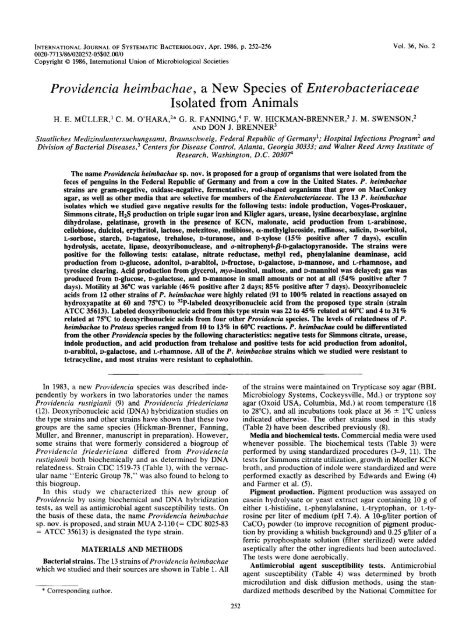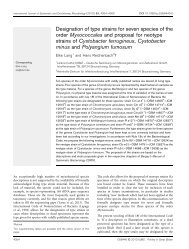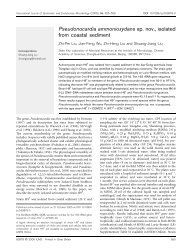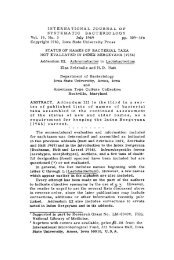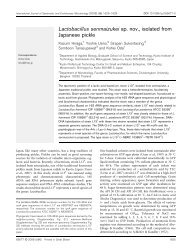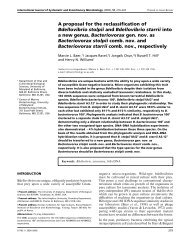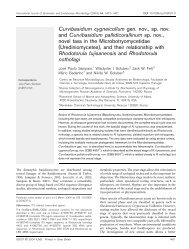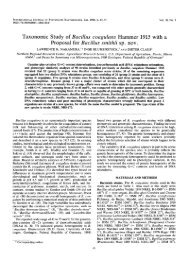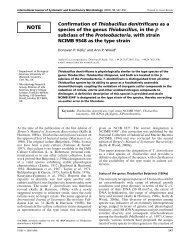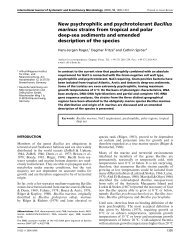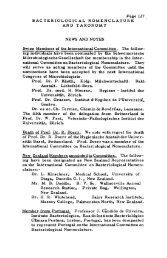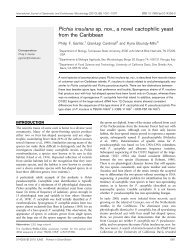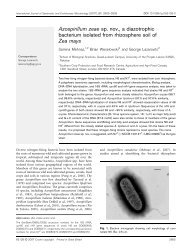Providencia heimbachae, a New Species of Enterobacteriaceae ...
Providencia heimbachae, a New Species of Enterobacteriaceae ...
Providencia heimbachae, a New Species of Enterobacteriaceae ...
You also want an ePaper? Increase the reach of your titles
YUMPU automatically turns print PDFs into web optimized ePapers that Google loves.
Apr. 1986, p. 252-256<br />
0020-7713/86/020252-05$02<br />
Copyright 0 1986, International Union <strong>of</strong> Microbiological Societies<br />
INTERNATIONAL JOURNAL OF SYSTEMATIC BACTERIOLOGY,<br />
.OO/O<br />
Vol. 36, No. 2<br />
<strong>Providencia</strong> <strong>heimbachae</strong>, a <strong>New</strong> <strong>Species</strong> <strong>of</strong> <strong>Enterobacteriaceae</strong><br />
Isolated from Animals<br />
H. E. MULLER,l C. M. O’HARA,2* G. R. FANNING,4 F. W. HICKMAN-BRENNER,3 J. M. SWENSON,2<br />
AND DON J. BRENNER3<br />
Staatliches Medizinaluntersuchungsamt, Braunschweig, Federal Republic <strong>of</strong> Germany‘; Hospital Infections Program2 and<br />
Division <strong>of</strong> Bacterial disease^,^ Centers for Disease Control, Atlanta, Georgia 30333; and Walter Reed Army Institute <strong>of</strong><br />
Research, Washington, D.C. 203074<br />
The name <strong>Providencia</strong> <strong>heimbachae</strong> sp. nov. is proposed for a group <strong>of</strong> organisms that were isolated from the<br />
feces <strong>of</strong> penguins in the Federal Republic <strong>of</strong> Germany and from a cow in the United States. P. <strong>heimbachae</strong><br />
strains are gram-negative, oxidase-negative, fermentative, rod-shaped organisms that grow on MacConkey<br />
agar, as well as other media that are selective for members <strong>of</strong> the <strong>Enterobacteriaceae</strong>. The 13 P. <strong>heimbachae</strong><br />
isolates which we studied gave negative results for the following tests: indole production, Voges-Proskauer,<br />
Simmons citrate, H2S production on triple sugar iron and Kligler agars, urease, lysine decarboxylase, arginine<br />
dihydrolase, gelatinase, growth in the presence <strong>of</strong> KCN, malonate, acid production from L-arabinose,<br />
cellobiose, dulcitol, erythritol, lactose, melezitose, melibiose, a-methylglucoside, rafhose, salicin, D-sorbitol,<br />
L-sorbose, starch, D-tagatose, trehalose, D-turanose, and D-XylOSe (15 % positive after 7 days), esculin<br />
hydrolysis, acetate, lipase, deoxyribonuclease, and u-nitrophenyl-P-D-galactopyranoside. The strains were<br />
positive for the following tests: catalase, nitrate reductase, methyl red, phenylalanine deaminase, acid<br />
production from D-glucose, adonitol, D-arabitol, D-fructose, D-galactose, D-mannOSe, and L-rhamnose, and<br />
tyrosine clearing. Acid production from glycerol, myu-inositol, maltose, and D-mannitol was delayed; gas was<br />
produced from D-glucose, D-galactose, and D-mannose in small amounts or not at all (54% positive after 7<br />
days). Motility at 36°C was variable (46% positive after 2 days; 85% positive after 7 days). Deoxyribonucleic<br />
acids from 12 other strains <strong>of</strong> P. <strong>heimbachae</strong> were highly related (91 to 100% related in reactions assayed on<br />
hydroxyapatite at 60 and 75°C) to 32P-labeled deoxyribonucleic acid from the proposed type strain (strain<br />
ATCC 35613). Labeled deoxyribonucleic acid from this type strain was 22 to 45 % related at 60°C and 4 to 31 %<br />
related at 75°C to deoxyribonucleic acids from four other Providenciu species. The levels <strong>of</strong> relatedness <strong>of</strong> P.<br />
heimbachue to Pruteus species ranged from 10 to 13% In 60°C reactions. P. <strong>heimbachae</strong> could be differentiated<br />
from the other Pruvidencia species by the following characteristics: negative tests for Simmons citrate, urease,<br />
indole production, and acid production from trehalose and positive tests for acid production from adonitol,<br />
D-arabitol, D-galactose, and L-rhamnose. All <strong>of</strong> the P. <strong>heimbachae</strong> strains which we studied were resistant to<br />
tetracycline, and most strains were resistant to cephalothin.<br />
In 1983, a new <strong>Providencia</strong> species was described inde-<br />
pendently by workers in two laboratories under the names<br />
<strong>Providencia</strong> rustigianii (9) and <strong>Providencia</strong> friedericiana<br />
(12). Deoxyribonucleic acid (DNA) hybridization studies on<br />
the type strains and other strains have shown that these two<br />
groups are the same species (Hickman-Brenner, Fanning,<br />
Miiller, and Brenner, manuscript in preparation). However,<br />
some strains that were formerly considered a biogroup <strong>of</strong><br />
<strong>Providencia</strong> friedericiana differed from <strong>Providencia</strong><br />
rustigianii both biochemically and as determined by DNA<br />
relatedness. Strain CDC 1519-73 (Table l), with the vernac-<br />
ular name “Enteric Group 78,” was also found to belong to<br />
this biogroup.<br />
In this study we characterized this new group <strong>of</strong><br />
<strong>Providencia</strong> by using biochemical and DNA hybridization<br />
tests, as well as antimicrobial agent susceptibility tests. On<br />
the basis <strong>of</strong> these data, the name <strong>Providencia</strong> <strong>heimbachae</strong><br />
sp. nov. is proposed, and strain MUA 2-110 (= CDC 8025-83<br />
= ATCC 35613) is designated the type strain.<br />
MATERIALS AND METHODS<br />
Bacterial strains. The 13 strains <strong>of</strong> <strong>Providencia</strong> <strong>heimbachae</strong><br />
which we studied and their sources are shown in Table 1. All<br />
* Corresponding author.<br />
252<br />
<strong>of</strong> the strains were maintained on Trypticase soy agar (BBL<br />
Microbiology Systems, Cockeysville, Md.) or tryptone soy<br />
agar (Oxoid USA, Columbia, Md.) at room temperature (18<br />
to 28”C), and all incubations took place at 36 k 1°C unless<br />
indicated otherwise. The other strains used in this study<br />
(Table 2) have been described previously (8).<br />
Media and biochemical tests. Commercial media were used<br />
whenever possible. The biochemical tests (Table 3) were<br />
performed by using standardized procedures (3-9, 11). The<br />
tests for Simmons citrate utilization, growth in Moeller KCN<br />
broth, and production <strong>of</strong> indole were standardized and were<br />
performed exactly as described by Edwards and Ewing (4)<br />
and Farmer et al. (5).<br />
Pigment production. Pigment production was assayed on<br />
casein hydrolysate or yeast extract agar containing 10 g <strong>of</strong><br />
either L-histidine, L-phenylalanine, L-tryptophan, or L-ty-<br />
rosine per liter <strong>of</strong> medium (pH 7.4). A lO-g/liter portion <strong>of</strong><br />
CaC03 powder (to improve recognition <strong>of</strong> pigment produc-<br />
tion by providing a whitish background) and 0.25 g/liter <strong>of</strong> a<br />
ferric pyrophosphate solution (filter sterilized) were added<br />
aseptically after the other ingredients had been autoclaved.<br />
The tests were done aerobically.<br />
Antimicrobial agent susceptibility tests. Antimicrobial<br />
agent susceptibility (Table 4) was determined by broth<br />
microdilution and disk diffusion methods, using the stan-<br />
dardized methods described by the National Committee for
VOL. 36, 1986 PROVIDENCIA HEIMBACHAE SP. NOV. 253<br />
TABLE 1. List <strong>of</strong> <strong>Providencia</strong> <strong>heimbachae</strong> strains studied<br />
Straina<br />
CDC 8025-83T<br />
(= MUA 2-llOT<br />
= ATCC 35613*)<br />
CDC 8027-83<br />
(= MUA 1-152)<br />
CDC 8032-83<br />
(= MUA 1-154)<br />
CDC 8035-83<br />
(= MUA 1-134)<br />
CDC 8039-83<br />
(= MUA 1-140)<br />
CDC 8050-83<br />
(= MUA 1-135)<br />
CDC 8051-83<br />
(= MUA 1-136)<br />
CDC 8052-83<br />
(= MUA 1-138)<br />
CDC 8053-83<br />
(= MUA 1-139)<br />
CDC 8054-83<br />
(= MUA 1-150)<br />
CDC 8055-83<br />
(= MUA 1-151)<br />
CDC 8056-83<br />
(= MUA 2-202)<br />
CDC 1519-73<br />
(enteric group<br />
78)<br />
Isolated from:<br />
<strong>Species</strong> <strong>of</strong> penguin Source<br />
Aptenodytes patagonica Feces<br />
Aptenodytes patagonica<br />
Aptenodytes patagonica<br />
Spheniscus humboldti<br />
Spheniscus demersus<br />
Spheniscus humboldti<br />
Spheniscus humboldti<br />
Spheniscus demersus<br />
Spheniscus demersus<br />
Aptenodytes patagonica<br />
Aptenodytes patagonica<br />
Aptenodytes patagonica<br />
Feces<br />
Feces<br />
Feces<br />
Feces<br />
Feces<br />
Feces<br />
Feces<br />
Feces<br />
Feces<br />
Feces<br />
Feces<br />
Aborted bovine<br />
fetus<br />
' CDC, Centers for Disease Control, Atlanta, Ga.; MUA, Staatliches<br />
Medizinaluntersuchungsamt, Braunschweig, Federal Republic <strong>of</strong> Germany;<br />
ATCC, American Type Culture Collection, Rockville, MD.<br />
Clinical Laboratory Standards (14, 15). The drugs tested<br />
were supplied by the manufacturers. Ampicillin, carbenicillin,<br />
piperacillin, mezlocillin, ticarcillin, cephalothin,<br />
cefazolin , cefamandole, cefoxitin, cefuroxime, cefoperazone,<br />
cefotaxime, ceftazidime, moxalactam, ceftriaxone,<br />
gentamicin, amikacin, tobramycin, netilmicin, tetracycline,<br />
sulfamethoxazole-trimethoprim, sulfisoxazole, trimethoprim,<br />
and chloramphenicol were tested by both methods.<br />
Azlocillin, doxycycline, nalidixic acid, cinoxacin, nitr<strong>of</strong>urantoin,<br />
imipenem, and aztreonam were tested by the broth<br />
microdilution method only.<br />
DNA relatedness. Levels <strong>of</strong> DNA relatedness were determined<br />
by reacting 32P-labeled DNA from <strong>Providencia</strong><br />
<strong>heimbachae</strong> 8025-83T (T = type strain) with unlabeled DNAs<br />
from the 12 other <strong>Providencia</strong> <strong>heimbachae</strong> strains and other<br />
strains <strong>of</strong> interest (Table 2), using methods described elsewhere<br />
(2, 9, 10).<br />
RESULTS AND DISCUSSION<br />
Isolation <strong>of</strong> bacterial strains. Twelve <strong>of</strong> the <strong>Providencia</strong><br />
<strong>heimbachae</strong> strains were isolated from the feces <strong>of</strong> apparently<br />
healthy penguins, and one strain was isolated from an<br />
aborted bovine fetus (Table 1). The habitat <strong>of</strong> the new<br />
species seems to be the same as or similar to the habitat <strong>of</strong><br />
<strong>Providencia</strong> rustigianii, and <strong>Providencia</strong> <strong>heimbachae</strong> has<br />
been isolated frequently from the same animal sources,<br />
although it has not yet been isolated from humans. Its<br />
estimated occurrence in relation to that <strong>of</strong> <strong>Providencia</strong><br />
rustigianii is l:lO, which corresponds to the numbers isolated<br />
from penguins (12) as well as to the numbers <strong>of</strong> strains<br />
in the collection at the Centers for Disease Control (9).<br />
TABLE 2. Levels <strong>of</strong> DNA relatedness <strong>of</strong> <strong>Providencia</strong><br />
<strong>heimbachae</strong> ATCC 35613T to 12 other <strong>Providencia</strong> <strong>heimbachae</strong><br />
strains and strains belonging to other speciesu<br />
Relatedness to labeled DNA from<br />
<strong>Providencia</strong> <strong>heimbachae</strong> ATCC 35613T<br />
Relative Relative<br />
Source <strong>of</strong> unlabeled DNA binding Divergence binding<br />
ratio at<br />
60°C<br />
(%Y<br />
ratio at<br />
75°C<br />
(%Ib<br />
<strong>Providencia</strong> <strong>heimbachae</strong><br />
ATCC 35613T<br />
100 0.0 100<br />
<strong>Providencia</strong> <strong>heimbachae</strong> 100 0.5 100<br />
8027-83<br />
<strong>Providencia</strong> <strong>heimbachae</strong><br />
8039-83<br />
100 1 .o 99<br />
<strong>Providencia</strong> <strong>heimbachae</strong><br />
8050-83<br />
100 0.0 100<br />
<strong>Providencia</strong> <strong>heimbachae</strong><br />
8051-83<br />
100 0.5 100<br />
<strong>Providencia</strong> <strong>heimbachae</strong><br />
8052-83<br />
100 0.0 100<br />
Pro v idencia he im ba c ha e<br />
8053-83<br />
100 0.0 99<br />
<strong>Providencia</strong> <strong>heimbachae</strong><br />
8054-83<br />
100 0.0 99<br />
<strong>Providencia</strong> <strong>heimbachae</strong><br />
8055-83<br />
100 0.0 100<br />
<strong>Providencia</strong> <strong>heimbachae</strong><br />
8056-83<br />
100 0.0 100<br />
<strong>Providencia</strong> <strong>heimbachae</strong><br />
8032-83<br />
99 0.5 100<br />
<strong>Providencia</strong> heim ba c hae 99 0.5 100<br />
8035-83<br />
<strong>Providencia</strong> <strong>heimbachae</strong><br />
1519-73<br />
91 0.0 N D ~<br />
<strong>Providencia</strong> rustigianii<br />
0132-68T<br />
45 6.5 31<br />
<strong>Providencia</strong> alcalifaciens<br />
3370-67<br />
28 14.5 ND<br />
Pro v idencia re ttg e ri<br />
24 13.5<br />
6<br />
1163T<br />
<strong>Providencia</strong> stuartii<br />
2896-68<br />
22 15 .O<br />
4<br />
Proteus mirabilis PR-14 13 15.0 ND<br />
Proteus myx<strong>of</strong>aciens<br />
ATCC 19692T<br />
11 16.0 ND<br />
Proteus vulgaris PR-1<br />
10 16.0 ND<br />
Morganella morganii<br />
9 14.5 ND<br />
ATCC 25830T<br />
Escherichia coli K-12<br />
5 ND ND<br />
a Labeled DNA was reacted with unlabeled DNA from the same strain<br />
(homologous reaction) and with DNAs from other strains (heterologous<br />
reactions). Each reaction was done at least twice. Before normalization, the<br />
level <strong>of</strong> reassociation in homologous reactions averaged 55%. Control reac-<br />
tions, in which labeled DNA was incubated in the absence <strong>of</strong> unlabeled DNA,<br />
resulted in 0.5 to 1.5% binding to hydroxyapatite. These control values were<br />
subtracted before normalization.<br />
Relative binding ratios were determined as follows: [(percentage <strong>of</strong> DNA<br />
bound to hydroxyapatite in heterologous reaction)/(percentage <strong>of</strong> DNA bound<br />
to hydroxyapatite in homologous reaction)] x 100.<br />
Divergence was calculated on the assumption that a 1% decrease in the<br />
thermal stability <strong>of</strong> a heterologous DNA duplex compared with the thermal<br />
stability <strong>of</strong> the homologous DNA duplex was caused by 1% <strong>of</strong> the bases within<br />
the duplex that were unpaired; divergence was calculated to the nearest 0.5%.<br />
Np, Not determined.<br />
&1'<br />
DNA hybridization. Labeled DNA from the type strain<br />
<strong>of</strong> <strong>Providencia</strong> <strong>heimbachae</strong> was 91 to 100% related to DNAs<br />
from the 12 other <strong>Providencia</strong> <strong>heimbachae</strong> strains in DNA<br />
relatedness reactions done at 60°C. There was 0 to 0.5%
254 MULLER ET AL. INT. J. SYST. BACTERIOL.<br />
TABLE 3. Biochemical reactions <strong>of</strong> 13 <strong>Providencia</strong> <strong>heimbachae</strong><br />
strains and type strain ATCC 35613<br />
Test<br />
Indole"<br />
Methyl red<br />
Voges-Proskauer<br />
Citrate (Simmons)<br />
H2S production on Klieger or<br />
triple sugar iron agar<br />
Urea<br />
Phen ylalanine<br />
Lysine (Moeller)<br />
Arginine (Moellerj<br />
Ornithine (Moellerj<br />
Motility<br />
Gelatin (22 and 36°C)<br />
Growth in the presence <strong>of</strong><br />
KCN~<br />
Malonate<br />
D-Glucose, acid<br />
Gas<br />
Acid from:<br />
Adonitol<br />
L- Arabinose<br />
D-Arabitol<br />
Cellobiose<br />
Dulcitol<br />
Erythritol<br />
Fructose'<br />
D-Galactose<br />
Glycerol<br />
Glycogen<br />
myo-Inositol<br />
Inulin'<br />
Lactose<br />
Maltose<br />
D-Mannitol<br />
D-Mannose<br />
Melezitose"<br />
Melibiose<br />
a-CH3-glucoside<br />
Raffinose<br />
L-Rhamnose<br />
Salicin<br />
D-Sorbitol<br />
L-Sorbose'<br />
Starch'<br />
Sucrose<br />
Tagatose'<br />
Trehalose<br />
Turanosee<br />
D-Xylose<br />
Esculin hydrolysis<br />
Acid from mucate<br />
Tartrate (Jordan)d<br />
Acetate utilization<br />
Lipase (corn oil and Tween<br />
Deox yribonuclease<br />
N03- + NOz-<br />
Oxidase<br />
Catalase'<br />
o-Nitrophen yl- P-D-galactop yran-<br />
oside<br />
Citrate (Christensen)<br />
Tyrosine clearing<br />
Cumulative % positive Reaction <strong>of</strong><br />
after: type strain<br />
ATCC<br />
1 Day 2 Days 7 Days 35613<br />
ND~<br />
ND<br />
ND<br />
0<br />
0<br />
0<br />
100<br />
0<br />
0<br />
0<br />
15<br />
0<br />
8<br />
0<br />
100<br />
0<br />
92<br />
0<br />
62<br />
0<br />
0<br />
0<br />
92<br />
92<br />
0<br />
0<br />
8<br />
0<br />
0<br />
8<br />
0<br />
92<br />
0<br />
0<br />
0<br />
0<br />
100<br />
0<br />
0<br />
0<br />
0<br />
0<br />
0<br />
0<br />
0<br />
8<br />
0<br />
0<br />
23<br />
0<br />
0<br />
0<br />
100<br />
0<br />
100<br />
0<br />
39<br />
100<br />
0<br />
85<br />
0<br />
0<br />
0<br />
0<br />
ND<br />
0<br />
0<br />
0<br />
46<br />
0<br />
8<br />
0<br />
100<br />
0<br />
92<br />
0<br />
92<br />
0<br />
0<br />
0<br />
100<br />
92<br />
0<br />
0<br />
46<br />
0<br />
0<br />
54<br />
0<br />
100<br />
0<br />
0<br />
0<br />
0<br />
100<br />
0<br />
0<br />
0<br />
0<br />
0<br />
0<br />
0<br />
0<br />
8<br />
0<br />
0<br />
69<br />
0<br />
0<br />
0<br />
ND<br />
ND<br />
ND<br />
0<br />
92<br />
100<br />
~~~ ~ ~~ ~ ~~<br />
ND<br />
ND<br />
ND<br />
0<br />
0<br />
0<br />
ND<br />
0<br />
0<br />
0<br />
85<br />
0<br />
23<br />
0<br />
100<br />
54<br />
100<br />
0<br />
100<br />
0<br />
0<br />
0<br />
100<br />
100<br />
85<br />
0<br />
62<br />
0<br />
0<br />
92<br />
77<br />
100<br />
0<br />
0<br />
0<br />
0<br />
100<br />
0<br />
0<br />
0<br />
0<br />
31<br />
0<br />
0<br />
0<br />
15<br />
0<br />
0<br />
69<br />
0<br />
0<br />
0<br />
ND<br />
ND<br />
ND<br />
0<br />
100<br />
100<br />
a See text.<br />
' ND, Not done.<br />
- , Negative at the end <strong>of</strong> the incubation period; + , positive after 24 h or at<br />
the time <strong>of</strong> the test. The numbers in parentheses indicate the day on which the<br />
reaction became positive.<br />
Continued<br />
TABLE 4. Ranges <strong>of</strong> MICs and categories <strong>of</strong> susceptibility as<br />
determined by the disk diffusion method for strains <strong>of</strong> <strong>Providencia</strong><br />
<strong>heimbachae</strong><br />
____ ~~~ ~<br />
Drug MIC range (p.g/rnl)<br />
No. <strong>of</strong> strains in the following<br />
disk diffusion categories<br />
Sus- Inter- Resistceptible<br />
mediate ant<br />
Ampicillin"<br />
Carbenicillin<br />
Piperacillin<br />
Mezlocillin<br />
Azlocillin<br />
Ticarcillin<br />
Cephalothin"<br />
Cefazolin"<br />
Cefamandole<br />
Cefoxitin"<br />
Cefuroxime<br />
Cefoperazone<br />
Cefotaxime<br />
Ceftazidime<br />
Gentamicin<br />
Amikacin<br />
Tobram ycin<br />
Netilmicin<br />
Doxy c ycline<br />
Tetracycline<br />
Sulfamethoxazole-<br />
trimethoprimc<br />
Sulfisoxazole<br />
Trimethoprim<br />
Nalidixic acid<br />
Cinoxacin<br />
Nitr<strong>of</strong>urantoin<br />
Moxalactam<br />
Ceftriaxone<br />
Chloramphenicol"<br />
Imipenem<br />
Aztreanam<br />
50.25-16<br />
54<br />
51.0<br />
51.0<br />
51.0-16<br />
11.0<br />
4->32<br />
50.25-32<br />
50.25<br />
0.5-4<br />
50.25-2<br />
50.5-1.0<br />
sQ.25<br />
51.0<br />
50.5-1.0<br />
50.5-4<br />
50.25-2<br />
50.25-1.0<br />
8->32<br />
232<br />
5 1.210.06-2.410.12<br />
54-64<br />
51.0<br />
1 .O-4<br />
2-8<br />
32-64<br />
50.25<br />
50.5-1.0<br />
8-16<br />
0.25- 1 .O<br />
50.25<br />
10<br />
13<br />
13<br />
13<br />
NT~<br />
13<br />
2 1<br />
2 1 10<br />
12 1<br />
13<br />
11 1<br />
13<br />
13<br />
12<br />
13<br />
13<br />
13<br />
13<br />
13<br />
NT<br />
13<br />
13<br />
13<br />
13<br />
NT<br />
NT<br />
NT<br />
13<br />
13<br />
NT<br />
NT<br />
7 6<br />
a The following discrepancies between disk diffusion and MIC results were<br />
found: for ampicillin, three minor discrepancies; for cephalothin, one major<br />
and one minor; for cefazolin, one very major and one minor; for cefoxitin, one<br />
major; and for chloramphenicol, three minor discrepancies. See text.<br />
' NT, Not tested by the disk diffusion method.<br />
We tested a solution containing 19 parts <strong>of</strong> sulfamethoxazole to 1 part <strong>of</strong><br />
trimethoprim.<br />
divergence in the related DNA sequences, and the levels <strong>of</strong><br />
relatedness were as high in 75°C reactions as in 60°C<br />
reactions (Table 2). <strong>Providencia</strong> <strong>heimbachae</strong> was 22 to 45%<br />
related to the other four species <strong>of</strong> <strong>Providencia</strong>, 10 to 13%<br />
related to Proteus species, 9% related to Morganella<br />
morganii, and 5% related to Escherichia coli. Thus,<br />
<strong>Providencia</strong> <strong>heimbachae</strong> is a distinct species that phenotyp-<br />
ically and genetically belongs in the genus <strong>Providencia</strong>.<br />
Antimicrobial agent susceptibility. Table 4 shows the min-<br />
imal inhibitory concentration (MIC) ranges and the catego<br />
TABLE 3-Continued<br />
Results obtained by the standardized methods used at the Centers for<br />
Disease Control (3).<br />
Tests performed only at the Staatliches Medizinaluntersuchungsamt,<br />
Braunschweig, Federal Republic <strong>of</strong> Germany.<br />
The corn oil lipase test results were obtained by the standardized method<br />
used at the Centers for Disease Control (3), and Tween 80 lipase test was<br />
performed only at the Staatliches Medizinaluntersuchungsamt, Braunschweig,<br />
Federal Republic <strong>of</strong> Germany.
VOL. 36, 1986 PROVZDENCZA HEIMBACHAE SP. NOV. 255<br />
Test<br />
Indoleb<br />
Citrate (Simmons)<br />
Urea<br />
Motility (36°C)<br />
Growth in the presence<br />
<strong>of</strong> KCN<br />
Gas from D-glucose<br />
Acid from:<br />
Adonitol<br />
D-Arabitol<br />
D-Galactose<br />
i-Inositol<br />
D-Mannitol<br />
L-Rhamnose<br />
Trehalose<br />
TABLE 5. Tests useful for differentiating <strong>Providencia</strong> <strong>heimbachae</strong> from other <strong>Providencia</strong> suecies"<br />
Pro viden cia<br />
<strong>heimbachae</strong><br />
Pro viden c ia Pro videncia<br />
<strong>Providencia</strong> Pro vide n cia<br />
rus tigia n ii rettgeri alcalifaciens stuartii<br />
V (36)<br />
All data except the data for <strong>Providencia</strong> <strong>heimbachae</strong> were obtained from reference 6.<br />
See text.<br />
' +, 90% or more <strong>of</strong> the strains positive; V, 11 to 89% <strong>of</strong> the strains positive; -, 10% or less<br />
numbers in parentheses are percentages <strong>of</strong> strains that were positive after 2 days.<br />
Minimal gas production.<br />
ries <strong>of</strong> susceptibility as determined by the disk diffusion<br />
method. The discrepancies that occurred between zone size<br />
and MIC were designated very major, major, or minor errors<br />
(very major, susceptible by zone size but resistant by MIC;<br />
major, resistant by zone size but susceptible by MIC; minor,<br />
intermediate or moderate susceptibility as determined by<br />
one method). Very major errors occurred for one isolate<br />
with cefazolin; major or minor errors occurred with ampicil-<br />
lin, cephalothin, cefazolin, cefoxitin, and chloramphenicol.<br />
Tetracycline, cephalothin, ampicillin, cefazolin, cefoxitin,<br />
and chloramphenicol were the least active drugs, but the<br />
remaining drugs tested had good activities. All <strong>of</strong> the strains<br />
were resistant to tetracycline, and 10 <strong>of</strong> the 13 strains were<br />
resistant to cephalothin. Single strains were resistant to<br />
ampicillin, cefazolin, and cefoxitin (Table 4).<br />
Description <strong>of</strong> <strong>Providencia</strong> <strong>heimbachae</strong> sp. nov. For the new<br />
species described here we propose the name <strong>Providencia</strong><br />
<strong>heimbachae</strong> (heim. bach'ae. M. L. gen. fem. n. <strong>heimbachae</strong><br />
<strong>of</strong> Heimbach, to honor Friederike Heimbach, who isolated<br />
12 <strong>of</strong> the strains).<br />
Strains <strong>of</strong> <strong>Providencia</strong> <strong>heimbachae</strong> are gram-negative,<br />
oxidase-negative, catalase-positive, D-glucose-fermenting,<br />
nitrate-reducing, straight rod-shaped organisms that con-<br />
form to the definitions <strong>of</strong> the family <strong>Enterobacteriaceae</strong> (1)<br />
and the genus <strong>Providencia</strong> (16). They grow on Endo agar,<br />
MacConkey agar, and other similar selective media. Like<br />
members <strong>of</strong> other species <strong>of</strong> <strong>Providencia</strong>, strains <strong>of</strong><br />
<strong>Providencia</strong> <strong>heimbachae</strong> (particularly fresh isolates) develop<br />
a red to brown pigment on media containing aromatic amino<br />
acids, as well as a characteristic almondlike smell on phe-<br />
nylalanine agar (17). Furthermore, they have the other<br />
characteristics <strong>of</strong> this genus (Table 3). They are negative for<br />
the following tests: lysine and ornithine decarboxylases,<br />
arginine dihydrolase, deoxyribonuclease, lipase (both corn<br />
oil and Tween 80), gelatinase, H2S production on Kligler and<br />
triple sugar iron agars, malonate, mucate, acetate, tartrate,<br />
pectate, o-nitrophenyl-P-D-galactopyranoside, Voges-<br />
Proskauer, and acid production from L-arabinose,<br />
cellobiose, dulcitol, D-lactose, melibiose, a-methyl-<br />
glucoside, raffinose, and D-sorbitol. They are positive for the<br />
following tests: acid production from D-mannose, methyl<br />
<strong>of</strong> the strains positive. All tests were performed at 36 * 1°C. The<br />
red, phenylalanine deaminase, and tyrosine clearing.<br />
<strong>Providencia</strong> <strong>heimbachae</strong> can be differentiated from other<br />
<strong>Providencia</strong> species by its negative tests for Simmons cit-<br />
rate, growth in the presence <strong>of</strong> KCN, acid production from<br />
trehalose, urease, and indole production and by positive<br />
tests for acid production from adonitol, D-arabitol, D-galac-<br />
tose, and L-rhamnose (Table 5). Motility at 36°C is variable<br />
and weak (46% positive after 2 days; 85% positive after 3 to<br />
7 days), and the gas produced in small amounts from<br />
D-glucose, D-galactose, and D-mannose by some strains is<br />
like that produced by <strong>Providencia</strong> rustigianii (<strong>of</strong>ten a pin-<br />
head-sized gas bubble in a Durham tube). Additional char-<br />
acteristics <strong>of</strong> <strong>Providencia</strong> <strong>heimbachae</strong> are given in Tables 3<br />
through 5.<br />
Some biochemical tests give different results when me-<br />
dium ingredients or methods are varied. The indole reaction<br />
is negative when bacteriological neutralized peptone (Oxoid<br />
USA), Polypeptone (BBL), or casein hydrolysate (E. Merck<br />
AG, Darmstadt, Federal Republic <strong>of</strong> Germany) is used;<br />
however, it is weakly positive after 2 to 7 days when<br />
tryptone (Oxoid USA) or peptone is used along with 0.1%<br />
tryptophan (2). The citrate reaction is negative only under<br />
standardized conditions (4). Traces <strong>of</strong> readily metabolized<br />
substances, such as peptone or glucose, may lead to false-<br />
positive results. The KCN test is negative under standard-<br />
ized conditions, as described previously (5); however, weak<br />
positive results are obtained if the test is performed as<br />
described by Cowan (3) or Munson (13).<br />
The similar biochemical reactions <strong>of</strong> <strong>Providencia</strong><br />
<strong>heimbachae</strong> and <strong>Providencia</strong> rustigianii, including weak or<br />
delayed motility, weak or no production <strong>of</strong> gas from sugars,<br />
and inability to utilize acetate, citrate, or tartrate, indicate<br />
that these two species are phenotypically more similar to<br />
each other than to the other three species <strong>of</strong> <strong>Providencia</strong>.<br />
The similarity between <strong>Providencia</strong> <strong>heimbachae</strong> and<br />
<strong>Providencia</strong> rustigianii may in part reflect the the common<br />
habitat <strong>of</strong> the two species (i.e., the intestines <strong>of</strong> healthy<br />
penguins [12] and probably also other animals).<br />
Description <strong>of</strong> the type strain. The type (holotype) strain <strong>of</strong><br />
<strong>Providencia</strong> <strong>heimbachae</strong> is strain MUA 2-110 (= CDC<br />
8025-83 = ATCC 35613). This strain was isolated from the
256 MULLER ET AL. INT. J. SYST. BACTERIOL.<br />
feces <strong>of</strong> a penguin (Aptenodytes patagonica) in a West<br />
German zoo by F. Heimbach. Its phenotypic characteristics<br />
(Table 3) are essentially those <strong>of</strong> the species.<br />
1.<br />
2.<br />
3.<br />
4.<br />
5.<br />
6.<br />
7.<br />
LITERATURE CITED<br />
Brenner, D. J. 1984. Family 1. <strong>Enterobacteriaceae</strong> Rahn 1937,<br />
Nom. fam. cons. Opin 15, Jud. Comm. 1958, 73; Ewing,<br />
Farmer, and Brenner 1980, 674; Judicial Commission 1981, 104,<br />
p. 408420. In N. R. Krieg and J. G. Holt (ed.), Bergey’s manual<br />
<strong>of</strong> systematic bacteriology, vol. 1. The Williams & Wilkins Co.,<br />
Baltimore.<br />
Brenner, D. J., J. J. Farmer 111, G. R. Fanning, A. G.<br />
Steigerwalt, P. Klykken, H. G. Wathen, F. W. Hickman, and W.<br />
H. Ewing. 1978. Deoxyribonucleic acid relatedness <strong>of</strong> Proteus<br />
and <strong>Providencia</strong> species. Int. J . Syst. Bacteriol. 28:269-282.<br />
Cowan, S. T. 1974. Cowan and Steel’s manual for the identifi-<br />
cation <strong>of</strong> medical bacteria, 2nd ed. Cambridge University Press,<br />
Cambridge.<br />
Edwards, P. R., and W. H. Ewing. 1972. Identification <strong>of</strong><br />
<strong>Enterobacteriaceae</strong>, 3rd ed. Burgess Publishing Co., Minneap-<br />
olis.<br />
Farmer, J. J., 111, M. A. Asbury, F. W. Hickman, D. J. Brenner,<br />
and the <strong>Enterobacteriaceae</strong> Study Group. 1980. Enterobacter<br />
sakuzakii: a new species <strong>of</strong> “<strong>Enterobacteriaceae</strong>” isolated from<br />
clinical specimens. Int. J. Syst. Bacteriol. 30569-584.<br />
Farmer, J. J., 111, B. R. Davis, F. W. Hickman-Brenner, A.<br />
McWhorter, G. P. Huntley-Carter, M. A. Asbury, C. F. Riddle,<br />
H. G. Wathen-Grady, C. Elias, G. R. Fanning, A. G. Steigerwalt,<br />
C. M. O’Hara, G. K. Morris, P. B. Smith, and D. J. Brenner.<br />
1985. Biochemical identification <strong>of</strong> new species and biogroups<br />
<strong>of</strong> Enterobactericeae isolated from clinical specimens. J. Clin.<br />
Microbiol. 21:46-76.<br />
Hickman, F. W., and J. J. Farmer 111. 1978. Salmonella typhi:<br />
identification, antibiograms, serology, and bacteriophage typ-<br />
ing. Am. J. Med. Technol. 44:1149-1159.<br />
8. Hickman, F. W., J. J. Farmer 111, A. G. Steigerwalt, and D. J.<br />
Brenner. 1980. Unusual groups <strong>of</strong> Morganella (“Proteus”)<br />
rnorganii isolated from clinical specimens: lysine-positive and<br />
ornithine-negative biogroups. J. Clin. Microbiol. 12:88-94.<br />
9. Hickman-Brenner, F. W., J. J. Farmer 111, A. G. Steigerwalt,<br />
and D. J. Brenner. 1983. <strong>Providencia</strong> rustigianii: a new species<br />
in the family <strong>Enterobacteriaceae</strong> formerly known as<br />
<strong>Providencia</strong> alcalifaciens biogroup 3. J. Clin. Microbiol.<br />
17: 1057-1060.<br />
10. Hickman-Brenner, F. W., G. P. Huntley-Carter, Y. Saitoh, A. G.<br />
Steigerwalt, J. J. Farmer 111, and D. J. Brenner. 1984.<br />
Moellerella wisconsensis, a new genus and species <strong>of</strong> <strong>Enterobacteriaceae</strong><br />
found in human stool specimens. J. Clin. Microbiol.<br />
19:460463.<br />
11. MacFaddin, J. F. 1980. Biochemical tests for identification <strong>of</strong><br />
medical bacteria, 2nd ed. The Williams & Wilkins Co., Baltimore.<br />
12. Miiller, H. E. 1983. <strong>Providencia</strong> friedericiana, a new species<br />
isolated from penguins. Int. J. Syst. Bacteriol. 33:709-715.<br />
13. Munson, T. E. 1974. Improved KCN medium. Appl. Microbiol.<br />
27:262-263.<br />
14. National Committee for Clinical Laboratory Standards. 1983.<br />
Tentative standard M7-T. Methods for dilution antimicrobial<br />
susceptibility tests for bacteria that grow aerobically. National<br />
Committee for Clinical Laboratory Standards, Villanova, Pa.<br />
15. National Committee for Clinical Laboratory Standards. 1983.<br />
Tentative standard M2-T3. Performance standards for antimi-<br />
crobial disk susceptibility tests. National Committee for Clinical<br />
Laboratory Standards, Villanova, Pa.<br />
16. Penner, J. L. 1984. Genus XII. <strong>Providencia</strong> Ewing 1962, 96*=,<br />
p. 494-496. In N. R. Krieg and J. G. Holt (ed.), Bergey’s manual<br />
<strong>of</strong> systematic bacteriology, vol. 1. The Williams & Wilkins Co. ,<br />
Baltimore.<br />
17. Polster, M., and M. Svoboda. 1964. Production <strong>of</strong> reddish-brown<br />
pigment from dl-tryptophan by <strong>Enterobacteriaceae</strong> <strong>of</strong> the<br />
Proteus-<strong>Providencia</strong> group. Experientia 20:637-638.


